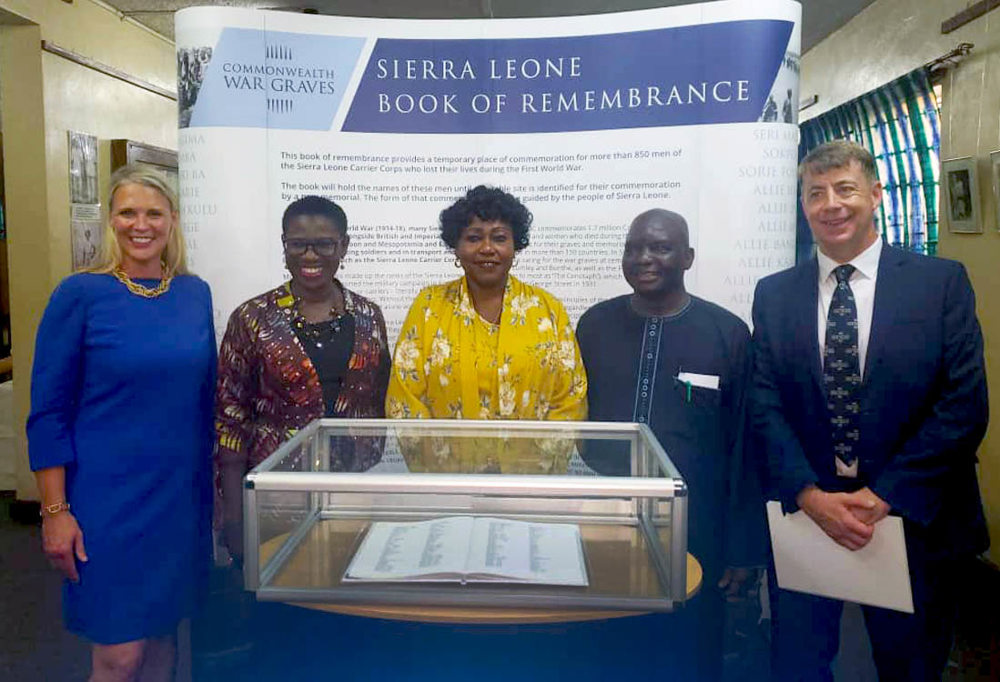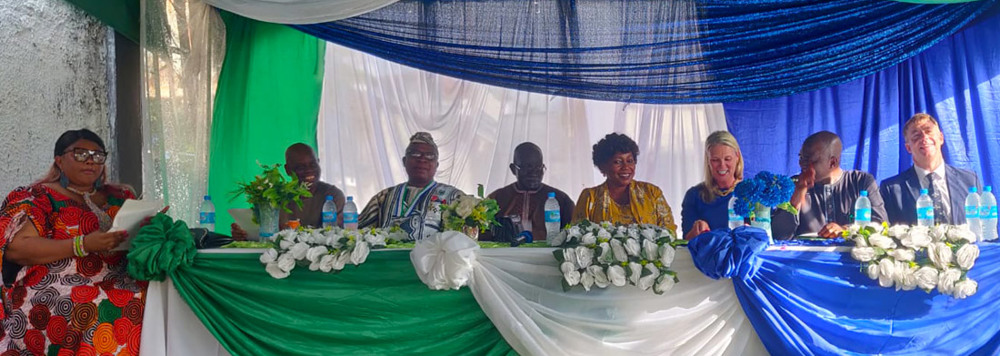Sierra Leone
Book of Remembrance

A Book of Remembrance, containing the names of more than 900 previously uncommemorated Sierra Leonean WW1 dead was formally handed over by the CWGC at the National Museum in Freetown on 22 June 2022.
The book, part of an initiative to honour these men for the first time, was accepted by Paramount Chief Sheku Amadu Tejan Fasuluku Chairman, National Council of Paramount Chiefs, on behalf of the people of Sierra Leone.
A new exhibition and nationwide radio campaign to find the families of the WW1 war dead was also launched at the handover ceremony. It is hoped the radio campaign will unearth the stories of those who died and the public’s views on how these men may be permanently memorialised in the future.


The Sierra Leone Carrier Corps (SLCC)
As a distinct and titled unit, the Sierra Leone Carrier Corps was established for service in East Africa at the beginning of 1917 when recruiting began through appeals to Chiefs and District Commissioners. Although fighting forces were in demand in this struggle, nothing could be achieved without transport. As the demand for manpower outstripped what was available in the theatre, British West African territories were asked to fill the deficit. Assembled in their respective districts before sailing from Freetown, nearly 5,000 Sierra Leoneans would ultimately travel to East Africa to do carrier service.
Once they arrived in East Africa, the Sierra Leone Carrier Corps saw near continuous service in support of the Gold Coast Regiment and Nigerian Brigade. In the course of its work, the SLCC suffered significant casualties, with many men losing their lives to diseases such as dysentery and tuberculosis. Malaria, however, probably claimed the most lives. While death rates among soldiers from sickness in East Africa in 1917 averaged around 3 to 4 men per thousand per month, the death rate among carrier forces rose from 5 per thousand in January and peaked at 27 per thousand in June before falling to 8 per thousand in November. Although contemporary figures vary, it was thought that at least 850 men who served in the SLCC did not live to see home again.
As in all the corners of the world touched by the war, the Imperial War Graves Commission (IWGC) was responsible for the commemoration of the war dead of what was then the British Empire. Discussions over how Sierra Leonean casualties would be commemorated in the aftermath started relatively late. In 1923 the colonial administration established a committee to oversee this work, which in turn liaised with the IWGC. Progress was initially slow, and the registration of graves and the production of cemetery plans within Sierra Leone took several years. By 1926 it was clear that, although they knew the cemeteries in which many Sierra Leoneans had been buried, the nature of their burials meant the graves were unidentifiable. Information from East Africa also suggested most burial locations for these men were unknown. The local committee and IWGC ultimately agreed that a central memorial in Freetown would be the best form of commemoration for all the Sierra Leonean dead, although there was some initial disagreement about the inclusion of names on the memorial.

Freetown Memorial photographed by Captain C E Cookson 11 March 1931
For several reasons, but principally due to a lack of records, the IWGC had built memorials to the dead in East Africa without inscribing their names upon them. The IWGC expected a similar approach would be adopted in Sierra Leone, but the local committee felt it was appropriate to use names as they were in their possession. Nonetheless, despite this wider decision, it was ultimately agreed that the names of the Sierra Leone Carrier Corps would be excluded as it was believed the communities from which these men came would not appreciate or engage with this form of commemoration. As they also made up the largest losses of any single Sierra Leonean unit, it was also noted that it would be considerably more difficult and expensive to find a way to add their names to the limited space on the memorial.
The final figures commemorated on the memorial included 61 men of the West African Regiment, 55 men of the Sierra Leone Battalion of the West African Frontier Force and 113 men of the Royal Engineers (Inland Water Transport). It omitted the names of 795 Sierra Leoneans known to have lost their lives doing carrier service in East Africa, who were instead remembered in number alone. This same fate was shared by two men originally of the Inland Water Transport and three of the Sierra Leone Medical Corps who had died as part of a contingent en route to Mesopotamia that was seconded at Dar es Salaam to act as carriers. The names of these men were recorded in memorial registers rather than in stone or bronze on the memorial itself.
This commemoration by number remained until after the Second World War, when the design of the memorial panels was altered to include the greater number of casualties from that conflict. As a result of this, all the First World War deaths were confined to a single panel and all trace of the Sierra Leone Carrier Corps was removed, apart from within the Commission’s registers.

History of the SLCC - Blog 1
 In this first blog, Dr. Festus Cole, Assistant Professor, Dept of History & Government, Bowie State University, Maryland, USA, covers the origins of the Sierra Leone Carrier Corps (SLCC).
In this first blog, Dr. Festus Cole, Assistant Professor, Dept of History & Government, Bowie State University, Maryland, USA, covers the origins of the Sierra Leone Carrier Corps (SLCC).
Born in Sierra Leone, West Africa, Festus Cole was educated at the Sierra Leone Grammar School, and the Albert Academy in Freetown. He later read History at the University of Sierra Leone, graduating with a Bachelor of Arts with Honors. In addition to a post-graduate Diploma in Education, he holds an M.A. in history from the University of Sierra Leone. A former Fellow of the Foreign and Commonwealth Office, he received his Ph.D. from the School of Oriental and African Studies, University of London.
With a specialty on Africa and World War I, his teaching experience spans three continents: Africa, the United Kingdom, and the US. Dr. Cole has taught African History, Imperialism in Africa, Global History, World History, World Civilizations, Twentieth Century European History, Western Civilization, US History, African American History, and Social Anthropology at Fourah Bay College University of Sierra Leone, The School of Oriental and African Studies, University of London, Birkbeck College, University of London, The Ohio State University, The State University of New York, North Carolina Wesleyan College, and Luther College, Iowa. He presently teaches at Bowie State University in Maryland.
Dr. Cole’s research interests are diverse and are of an interdisciplinary nature. These span the history of Africa and World War I, Imperialism in Africa, Problems of nation-building in contemporary Africa, the history of the Levantines in West Africa, the history of disease and medicine in colonial Africa, and nineteenth and twentieth century Anglo-Krio relations. Among his recent publications in peer reviewed journals, are, “Sanitation, Disease, and Public Health in Sierra Leone, West Africa, 1895-1922: Case Failure of British Colonial Health Policy.” The Journal of Imperial and Commonwealth History, “Defining the ‘flesh’ of the Black soldier in Colonial Sierra Leone: Background to the Gunners’ Mutiny of 1939.” Canadian Journal of African Studies, “In Defence of King and Country: Empire Loyalism, Sierra Leone and World War I.” Research in Sierra Leone Studies (RISLS): Weave, and “Anglo-Krio Relations: A Study of a Disadvantaged Community in a Colonial Setting, 1895-1922.” The Journal of Imperial and Commonwealth History.” Dr. Cole was a major contributor to New Perspectives on the Sierra Leone Krio.
History of the SLCC - Blog 2
In this second blog, Dr. Festus Cole, Assistant Professor, Dept of History & Government, Bowie State University, Maryland, USA, covers the problems encountered with recruiting carriers for the Sierra Leone Carrier Corps (SLCC).
History of the SLCC - Blog 3
In this third and final blog, Dr. Festus Cole, Assistant Professor, Dept of History & Government, Bowie State University, Maryland, USA, covers the impact on returnees from the Sierra Leone Carrier Corps (SLCC) after their service.


